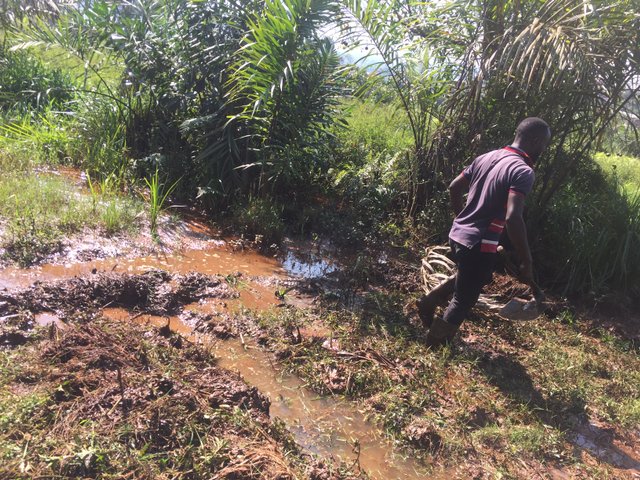Greetings my fellow steemians. It’s another bright day and I will be sharing with you my little experiment on drainage systems. Urban development is increasing and farmlands are reducing thus sending farmers to water logged areas. These areas are hard to work leading to a reduction of crop production. Most of these areas need personal efforts, money, time and energy to drained and put it under use.

Opening drainage channels.
Farm drainage management is the full responsibility of the landowner. Most farms especially in low level areas in Bamenda have some kind of surface drainage system and some have subsurface drainage systems.
These subsurface drainage are not problem free. They are sometimes blocked as well as damaged by roots, soil, farming equipment, and other plastic material transported form near by Environment.
Looking into this drainage issue, we need to identify the causes and come out with practical remedies which can help handle the situation.
Important information have been developed over the past years with the efforts to reduce the amount of drainage water. This has however been successful to reuse the available water.
The possible agricultural drainage solutions include the
- source control. This is aimed to reduce the amount of added water so as to reduce drainage water.
- Drainage reuse: making use of drainage water to irrigate salt-tolerant plants such as eucalyptus.
- Evaporation systems: laying off of residual drainage water in evaporation ponds.
- Land retirement: fallowing farmland that are difficult to be drained.
The soil keeps too much water depending on it texture. For agriculture to be successful, famers have come out with ways to drain excess water for their own need. This drainage is always necessary because the farmer’s soil are harmful to the crop productivity. When there is additional water to such zone, the soil elements are leached making the soil infertile for agriculture.
The water available in the soil carries with the salinity of the soil which is the degree of saltiness in water and the nature of the field slope and other factors that can help in crop growth.
However, when the soil is freely drained, the groundwater table will not be saturated, thus excess salts in water and water filters deeply underground. This filtering can increase contamination of groundwater sediments.
Furthermore, some rivers are used to transport salts from agricultural lands. Such drainage becomes part of the flow and salt is carried to the ocean. The main concern in these basins are whether the saltiness in the river can be kept below some levels that may harm downstream uses or aquatic and wildlife.
Thanks for reading
Wow nice, really didn't know there was this much to learn.
Downvoting a post can decrease pending rewards and make it less visible. Common reasons:
Submit
Those tips on drainage control are most important especially for cultivation in swampy areas. Thank you for sharing.
Downvoting a post can decrease pending rewards and make it less visible. Common reasons:
Submit
This post has been rewarded by @saxopedia from Steem Cameroon Community Account with support from the Steem Team."
Keep posting good content and follow @steem-cameroon for more updates. Keep on steeming as well as improving your content to get more attention.
Thank you, Steem Cameroon Team!
Downvoting a post can decrease pending rewards and make it less visible. Common reasons:
Submit